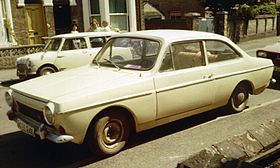Anadol
 |
|
| Private | |
| Industry | Automotive |
| Founded | 1966 |
| Defunct | 1991 |
| Headquarters | Istanbul, Turkey |
|
Key people
|
Vehbi Koç |
| Products | Automobile, Pick-Up |
| Parent | Koç Holding |
| Anadol A1 | |
|---|---|
 |
|
| Overview | |
| Production | 1966–1975 |
| Designer | Ogle |
| Powertrain | |
| Engine | |
| Transmission | 4-Speed Manual gearbox |
| Dimensions | |
| Wheelbase | 2,565 mm (101.0 in) |
| Length | 4,381 mm (172.5 in) |
| Width | 1,644 mm (64.7 in) |
| Height | 1,422 mm (56.0 in) |
| Curb weight | 828 kg (1,825.4 lb) |
Anadol was Turkey's first domestic mass-production passenger vehicle, and the second Turkish car after the ill-fated Devrim sedan of 1961.
Anadol cars and pick-ups were manufactured by Otosan Otomobil Sanayii in Istanbul between 1966 and 1991.
Seven Anadol models were produced:
A1 (1966–1975), A2 (1970–1981), STC-16 (1973–1975), SV-1600 (1973–1982), Böcek (1975–1977), A8-16 (1981–1984) and Otosan 500 Pick-Up (1971–1991).
Production of the Anadol passenger cars was discontinued in 1986, while the production of the Otosan 500 Pick-Up continued until 1991. At present, Otosan builds Ford Motor Company's passenger cars and commercial vehicles, which are exported to numerous countries in the world, particularly to the European Union member states.
The Anadol A1, code named FW5 by Reliant which developed the prototype upon Anadol's request, went into production on 19 December 1966. The styling of the A1 was by Tom Karen of Ogle Design. In 1967 a New Zealand entrepreneur, Alan Gibbs, announced that he intended to also produce the car in his country as the Anziel Nova. This project never proceeded beyond the initial announcement and prototype.
Production of the A1 started at Otosan's new eastside Istanbul plant on 16 December 1966 with the 1200 cc Cortina engine, but in October 1968 it was replaced with the stronger 1300 cc Kent engine. In 1969 the dashboard gauges were updated with a new design and their positions were changed, while the ergonomic design of the steering wheel was improved. In 1970 the two round headlamps at front were replaced with oval headlamps, a new transmission system was introduced, and the bumpers were changed. In 1971 the interior of the roof was covered with vinyl, in accordance with the fashion of that period. The design essentially remained this way until April 1972.
In 1971 a special model of the A1 was developed in dedication to the Mediterranean Games in İzmir, called the Akdeniz (Mediterranean). Anadol Akdeniz was like a prelude of the new model which arrived in 1972, and had bumpers which were integrated to the shape of the bodywork, a different front grille, rectangular headlamps with white signal lamps, and different rear lights. The interior of the car was also completely changed, with a new dashboard, new seats and new finishing materials. Starting from 1972, this model became the standard coupé of Anadol until its production was stopped in 1975.
...
Wikipedia
